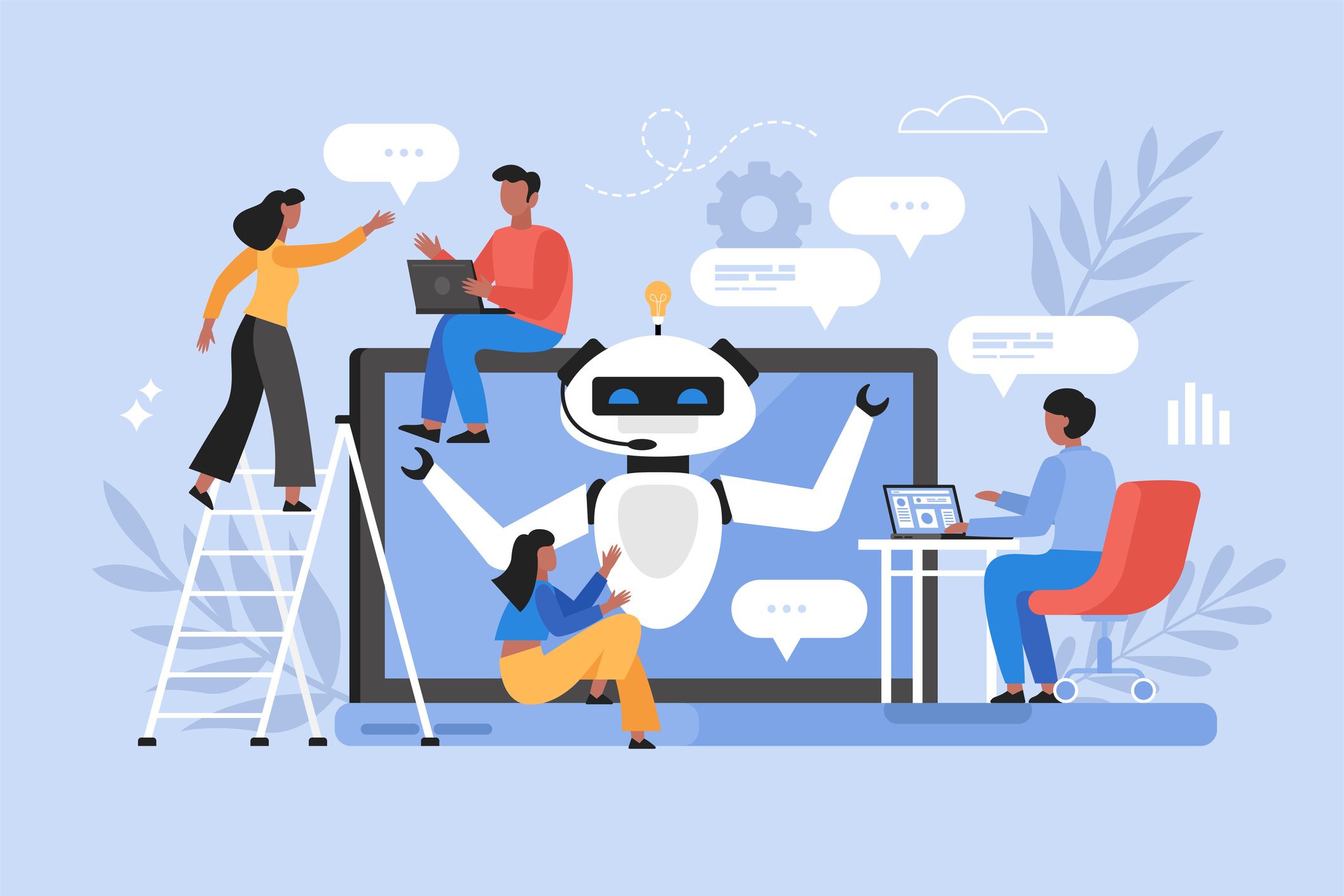Stefanie Ady (B.S., M.A.) is an experienced classroom teacher working in K-8 schools in Ohio. Alongside teaching, she is an educational writer specializing in ed tech, curriculum, and instructional design.
Read on for Stefanie's tips and ideas for making use of AI to enhance learning opportunities and student engagement in Social Studies, including a lesson plan for interviewing famous historical figures using AI chatbots.

The world is abuzz right now with using AI to create innovative learning experiences. AI can be intimidating at first, but ultimately, it is there to enhance and support rather than “take over”. The human aspect of creating and learning still absolutely needs to be there, and there is room for it!
Imagine you are back in school, and your teacher gives you guidelines for a project about a historical figure or event. So, you start googling and researching countless sources of information. AI has the ability to mimic the source itself. Using AI, you could “talk” to that historical figure, interview them, and “ask” them how you could best share their message or display their legacy to your classmates!
Combining artificial intelligence (AI) with social studies projects can revolutionize student engagement and deepen their understanding of historical events and influential figures. In this article, we will explore how to implement this project, provide examples of student approaches, and discuss how AI can be utilized for Black History Month, Women’s History Month, Famous Inventors, or other learning standards.
Interviewing Famous Historical Figures Using AI Chatbots
Follow these steps to create your very own Social Studies project that utilizes AI tools and creates an engaging, exciting, and personalized learning experience for students.
Step 1: Introduce the Project and Select Historical Figures
- Explain the purpose of the project and its connection to history.
- Collaboratively decide on a list of significant historical figures to be "interviewed."
- Provide external resources for students to conduct research on their chosen figure's life and contributions. They should do their own research and reading first so that when prompting AI, they can ask more effective questions.
Step 2: Utilize AI Chatbot Platforms
- Practice using AI yourself, conducting “interviews” before the assignment.
- Introduce students to AI chatbot platforms that can simulate conversations with historical figures – for example, ChatGPT or Kuki AI (previously Mitsuku).
- Familiarize students with the features and capabilities of the chosen platform.
- Demonstrate how to input questions and receive responses from the AI chatbot.
Step 3: Student Approaches and Presentation of Knowledge
Role-Play Dialogue
- Students can create a dialogue between themselves and the AI chatbot, representing a conversation with the historical figure.
- They can role-play both sides of the conversation, asking questions as the interviewer or answering as the historical figure based on their research. The chatbot can interview them!
- Present the dialogue through a video recording, live performance, or a written script.
Interview Documentary
- Students can compile the information gathered from the AI chatbot, along with their research, into a documentary-style video.
- They can incorporate visuals, images, voice-overs, and music to present the historical figure's life and achievements.
- Encourage creativity and effective storytelling techniques to engage the audience.
Digital Storytelling
- Students can transform their acquired knowledge into a digital story using multimedia tools like PowerPoint, Prezi, or digital storytelling platforms.
- They can combine text, images, audio, and video to create an interactive and engaging presentation about the historical figure.
- Encourage students to highlight the significance and lasting impact of their chosen figure's contributions.
Lesson Plan: Abraham Lincoln Research Project (Using AI Tools)
Students can leverage AI to research and deliver a comprehensive report about Abraham Lincoln during the Civil War.
1. Research Assistance
The student can use AI-powered search engines or research platforms, such as Google or Microsoft Academic, to gather relevant information about Abraham Lincoln’s role during the Civil War. These platforms utilize AI algorithms to provide targeted search results, scholarly articles, and primary sources.
2. AI Chatbot Interview
To gain deeper insights into Abraham Lincoln’s thoughts and decisions during the Civil War, the student can engage in a simulated interview with an AI chatbot designed to mimic Lincoln’s responses. Platforms like ChatGPT or Kuki AI (previously Mitsuku) can provide conversational experiences, allowing students to ask questions and receive AI-generated responses based on historical records and speeches.
3. Data Analysis and Fact Checking
After conducting the interview and gathering research material, the student can use AI-powered tools like IBM Watson’s Natural Language Understanding or Factmata to analyze the credibility and factuality of the information they’ve collected. These tools employ machine learning algorithms to detect bias, verify sources, and evaluate the accuracy of historical claims.
4. Content Organization and Summarization
AI-supported tools like GPT-3-powered writing assistants or mind-mapping platforms can assist students in organizing their research findings and generating coherent summaries. These tools can help structure the report by outlining key points, identifying supporting evidence, and providing suggestions for concise and effective writing.
5. Presentation Enhancement
To deliver an engaging report, the student can incorporate AI-enhanced presentation tools such as PowerPoint with AI Designer or Prezi. These platforms offer AI-powered features that suggest visual layouts, provide design recommendations, and enhance the overall aesthetics of the presentation.
Adapting the Lesson Plan for Different Projects
This lesson plan can be adapted for different celebrations throughout the school year, such as Black History Month, Women’s History Month, Asian and Pacific Islander Heritage Month, Native American Studies, Poetry Month — or any other project needs you might have. Many social Studies Curricula ask educators to incorporate Scientists and Inventors into learning activities. Perhaps AI could advise a student on how best to complete an egg drop challenge or other STEM challenges. Allowing students to “talk” to experts in a field can help them learn about the motivations and problem-solving behind the world's greatest inventions.
What are the Benefits of This Approach?
Hopefully, in the near future, professional development opportunities for harnessing AI as a powerful learning tool will become available to districts and schools. Using AI for learning can enhance student engagement, stimulate students' curiosity, foster active learning, and encourage them to think critically while interacting with historical figures and other content. It also can provide personalized learning experiences — AI chatbots can adapt responses based on students' questions, offering personalized interactions and tailored feedback while providing practice with emerging digital literacy skills. Students can most importantly gain a deeper understanding of historical events and figures by immersing themselves in simulated conversations, fostering empathy and a connection to the past.
Using AI Tools to Enhance Learning
Aside from the positive effects it could have on Social Studies instruction while posing as historical figures, AI-powered intelligent tutoring systems act as virtual tutors, providing individualized support, feedback, and guidance to students. These systems can analyze student responses, identify misconceptions, and offer tailored explanations to foster deeper understanding. For example, chatbot assistants, such as Duolingo or Socratic, utilize natural language processing and machine learning to engage in interactive conversations with students. They can answer questions, provide explanations, and guide students through complex problem-solving tasks. An encouraging example of this would be a student struggling with a math problem and interacting with a chatbot that walks them through the steps and offers hints to arrive at the correct solution.
Educators are constantly seeking innovative ways to enhance student learning experiences. Artificial Intelligence (AI) has emerged as a powerful tool that can support and transform education. By leveraging AI technologies, teachers can create personalized, engaging, and adaptive learning environments that cater to individual student needs.










